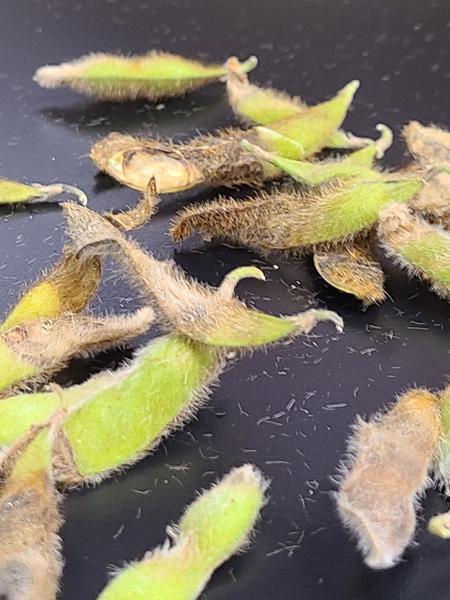Introduction
Anthracnose is a fungal disease affecting maturing soybean stems and pods. Late season occurrence may affect crop stand, yield, and seed quality. Symptoms may be mistaken for pod and stem blight (Diaporthe phaseolorum), however symptoms differ and both diseases can be observed together, late season.
Pathogen
The fungus Colletotrichum truncatum is the most common causal agent of anthracnose; however, several other species of Colletotrichum have been identified. The fungus spreads via asexual spores (conidia), and produces black fruiting bodies (acervuli) that develop spines (setae) on the stems when plants are mature.
Symptoms
In the field, disease usually is present in patches where defoliation and wilting may be observed. Anthracnose presents with red to brown dark irregular lesions on stems, pods, and petioles (Figure 1). Affected petioles may present a “shepherd’s crook” appearance or develop brown cankers, and later premature defoliation. Later during infection, fruiting bodies can be observed as black dots (acervuli) containing spines (setae) on the external surface of infected tissue. Pod infection may result in no seed due to fungal colonization of the entire pod. Leaf symptoms include vein reddening and leaf rolling.
Life Cycle and Favorable Conditions for Disease
Anthracnose is favored by warm wet weather, and plants may be infected at any point during the growing season. Colletotrichum spp. overwinter in crop debris and may be seedborne. Conidia are dispersed from acervuli (black and round fruiting bodies that form on external infected tissue) infecting soybean stems, petioles, leaves, and pods. At the end of the growing season, crop debris left in the field harbor inoculum that may start the disease epidemic in the next growing season with soybeans.
Management
Soybean varieties may differ in susceptibility to anthracnose. Fungicide-treated seed may reduce early-season infections in areas with high inoculum pressure. Foliar fungicides applied in early reproductive stages may reduce disease; however, there are few situations where fungicide applications are profitable for anthracnose. Crop rotation and burying infected crop debris may promote inoculum breakdown and reduce disease incidence in future stands.
Useful Resources
The Crop Protection Network Fact Sheet for anthracnose has more images and descriptions for diagnosis help.
The NC State University Plant Disease and Insect Clinic provides diagnostics and control recommendations.
The NC State Extension Plant Pathology portal provides information on crop disease management
The North Carolina Agricultural Chemicals Manual provides pesticide information for common diseases of North Carolina. The manual recommendations do not replace those described on the pesticide label, and the label must be followed.
Acknowledgements
This factsheet was prepared by the NC State University Field Crops and Tobacco Pathology Lab in 2020.
- Check out our Facebook and our Twitter!
Publication date: Sept. 8, 2020
N.C. Cooperative Extension prohibits discrimination and harassment regardless of age, color, disability, family and marital status, gender identity, national origin, political beliefs, race, religion, sex (including pregnancy), sexual orientation and veteran status.
NC Cooperative Extension prohíbe la discriminación por raza, color, nacionalidad, edad, sexo (incluyendo el embarazo), discapacidad, religión, orientación sexual, identidad de género, información genética, afiliación política, y estatus de veteran.
The use of brand names in this publication does not imply endorsement by NC State University or N.C. A&T State University of the products or services named nor discrimination against similar products or services not mentioned.
Recommendations for the use of agricultural chemicals are included in this publication as a convenience to the reader. The use of brand names and any mention or listing of commercial products or services in this publication does not imply endorsement by NC State University or N.C. A&T State University nor discrimination against similar products or services not mentioned. Individuals who use agricultural chemicals are responsible for ensuring that the intended use complies with current regulations and conforms to the product label. Be sure to obtain current information about usage regulations and examine a current product label before applying any chemical. For assistance, contact your local N.C. Cooperative Extension county center.
N.C. Cooperative Extension prohibits discrimination and harassment regardless of age, color, disability, family and marital status, gender identity, national origin, political beliefs, race, religion, sex (including pregnancy), sexual orientation and veteran status.

